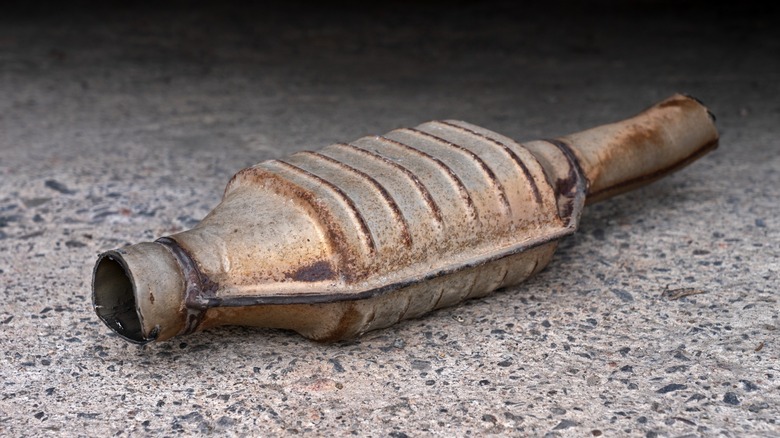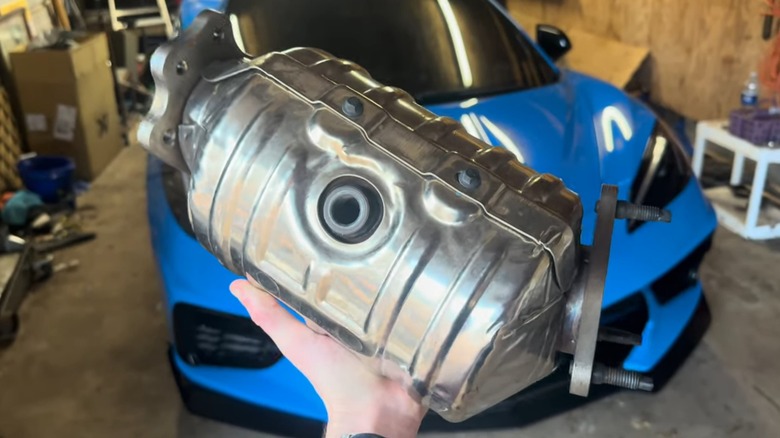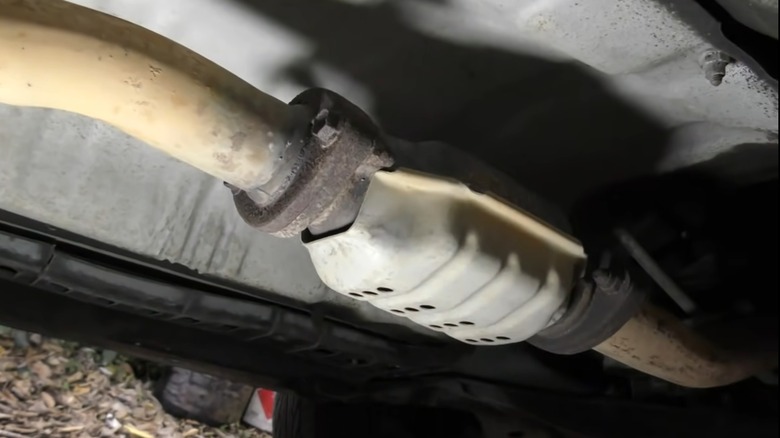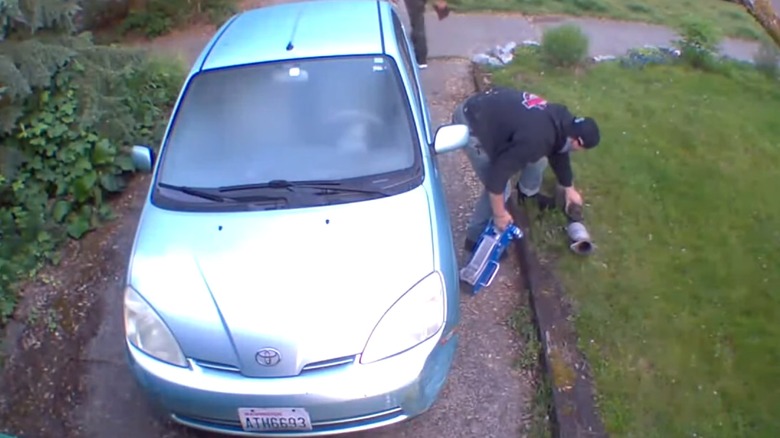What Are Catalytic Converters, And Why Is Nearly Every Car Required To Have One?
Modern vehicles and the internal combustion engines that power them — well, most of them, that is — have come a long way in recent decades. From inefficient carburetor systems to fuel injection and, now, hybrids, our cars are more eco-friendly than ever. We have modern emissions control systems to thank for many of those improvements, like cleaner air and better gas mileage. However, not everyone is a fan of emissions control systems, while others just don't understand what they do. The catalytic converter or cat is an infamous and mandatory part of most modern vehicles' exhaust and emissions control systems. You may have heard the term in connection with a string of robberies, or maybe your mechanic recently told you that yours is bad, and you need to fork over a large sum to replace it. Regardless, if you're curious about what these devices are and why they're mandated by law, stick around.
First and foremost, catalytic converters are designed to help transform extremely harmful pollutants, like nitrogen oxide, carbon monoxide, and nitrogen dioxide, into less harmful molecules like water, nitrogen, and carbon dioxide. They're able to achieve this feat thanks to complex — and expensive — metallic interior components and extremely high temperatures. However, that's a pretty base-level explanation. If you're interested in learning more about catalytic converters, how they work, why they're important, and more, we've got you covered. As a former professional automotive repair technician and a lifelong gearhead, I'll break it all down. I'll explain how catalytic converters work, what types of vehicles are required to have them, why people steal them, and even how much it costs to replace one. Let's dive in and check it out.
[Featured image by Santeri Viinamäki via Wikimedia Commons | Cropped and scaled | CC BY-SA 3.0]
Why are catalytic converters necessary, and how do they work?
If you live in the United States and drive a relatively modern car, chances are it has a catalytic converter — or, at least, it should have one. These devices became standard in the mid-1970s, after the U.S. government passed the Clean Air Act of 1970. The act required all passenger vehicles built from 1975 and onward to be equipped with catalytic converters to cut down on rampant emissions. It was a successful move, as modern vehicles now burn roughly 98% cleaner than their 1960s predecessors, and smog levels have dropped noticeably from several major city skylines. But how exactly do catalytic converters work?
Catalytic converters usually look like a boxy tube. They contain a series of filters or honeycombs coated with precious metals, like palladium and platinum, and are located between the engine's exhaust manifold or headers and the muffler. Oxygen sensors connect to the outside and send vital information about the exhaust to the vehicle's computer. Depending on the car, you can find the cat under the vehicle's mid-section or closer to the engine. Regardless, the point is that your car's exhaust gasses pass through the catalytic converter before entering the air we breathe.
When the extremely hot exhaust gasses pass through the honeycombs, a chemical reaction occurs, transforming the highly-toxic pollutants into less harmful molecules like water. Older vehicles usually have two-way catalytic converters, meaning they can change carbon monoxide into carbon dioxide and hydrocarbons into water. However, cars built after 1981 typically have three-way catalytic converters, which go one step farther to convert harmful nitrogen oxides into regular nitrogen and oxygen. No matter the type of catalytic converter that your car has, if it was built after 1975, legally, it has to have one.
What are the symptoms of a faulty catalytic converter?
Considering the importance of catalytic converters and the fact that you're required by law to have one, it's a good idea to familiarize yourself with the symptoms of one that's gone bad. Faulty catalytic converters typically display a few standard symptoms. However, some of these issues can indicate other mechanical malfunctions, so you'll most likely still need a professional inspection if you experience them.
One of the classic and defining symptoms of a faulty catalytic converter is a strong smell of rotten eggs or sulfur coming from the exhaust. The issue occurs when your cat develops a large buildup of unconverted hydrogen sulfides. When your catalytic converter is functioning normally, it converts hydrogen sulfides into sulfur dioxides. However, if it fails to do its job properly, those bad gasses can pass through the cat, leading to a strong and unpleasant smell of rotten eggs.
Outside of a foul odor, a faulty catalytic converter can display various other symptoms. One of the first things you may notice if your cat is bad is a lit check engine light, one of the many dashboard warning lights your vehicle may display. The check engine light can appear for various reasons, though, so you'll need an OBDII scan tool or a mechanic's assistance to diagnose it. Other common signs of a faulty catalytic converter include things like a failed emissions or SMOG test, strange sounds, poor overall performance, reduced fuel economy, and the inability to start your car altogether. Remember, though, that most of these symptoms can indicate other problems with your vehicle. So, if you experience them yourself, you should visit a professional mechanic for an inspection.
Can you drive your car with a bad catalytic converter or remove it completely?
If your catalytic converter goes bad, you may wonder if it's okay to keep driving until you can get it fixed. Alternatively, you might be curious if you can remove your catalytic converter altogether. Legally speaking, your car has to have a catalytic converter if it was built with one. Federal law, meaning rules that apply to every state in the country, prohibits drivers from deleting or otherwise tampering with their catalytic converters. That means that you can't just remove your catalytic converter without replacing it with an EPA-approved piece of equipment.
You can technically remove your catalytic converter and hope that no one notices — if you live in a state that doesn't require regular SMOG testing, you may even be able to get away with it. However, if you remove your catalytic converter, you'll leave a large gap in your exhaust system. That will cause your vehicle to run extremely loudly, and it will probably attract the attention of local law enforcement officers. Instead of removing the cat, if you're looking for a performance upgrade that can also help make your exhaust system sound better, a cat-back exhaust system could be exactly what you need.
But maybe you have no interest in deleting the catalytic converter and are just wondering if it's okay to drive with a bad one until you can get it fixed. In that case, you can continue driving your car until you're able to pay someone to fix it. However, remember that you'll dump excess pollutants into the atmosphere, get worse fuel mileage, and experience various other symptoms until you replace the cat. Like the symptoms mentioned above, if you have a bad catalytic converter, it's important that you prioritize a visit to your local mechanic as soon as possible.
How much does it cost to replace a catalytic converter, and can you DIY the replacement?
Considering that you're legally required to have a catalytic converter and the frequency with which they're stolen, you may be curious how much it costs to replace one and whether you can do it yourself. First, if your catalytic converter is stolen, call your insurance company and file a report. If you have comprehensive insurance, you probably won't have to pay for the replacement. However, if your catalytic converter fails due to old age or a mechanical issue, you'll most likely have to pay for the service yourself. Depending on the vehicle, the replacement can be pricey. New catalytic converters can cost anywhere from a few hundred to several thousand dollars. You'll also have to pay for the mechanic's labor time, which can cost between $75 and $300 or more, depending on the rates in your area.
Knowing that the part alone is so expensive, you may be wondering if a DIY replacement is possible to save on labor costs. While not one of the easiest DIY auto projects for beginners, replacing your own catalytic converter is possible. If you're an experienced home mechanic and have access to the proper tools, you probably won't struggle too much. However, if you're a complete car novice, you're probably better off going to a pro — the bulk of the cost is the part anyway. One thing to keep in mind, whether you're a novice or an expert, is that if you're replacing a stolen catalytic converter, you might have to do some welding to install a new one. Thieves usually cut the old cats off to save time during the removal process. Sometimes, you can use clamps to install a replacement, but it's often essential to weld new piping.
Why do some people steal catalytic converters?
We mentioned briefly that one of the reasons you may have heard the words "catalytic converter" is because you or someone you know has been the victim of catalytic converter theft. Unfortunately, it's a relatively common occurrence. Catalytic converters are usually located under the car in fairly easy-to-access locations. Taller vehicles, like pickup trucks and SUVs, are especially easy marks. But catalytic converters aren't simply easy to access, many of them also contain extremely valuable metals: platinum, palladium, and rhodium. Those precious metals, combined with the relative ease with which you can remove a catalytic converter, make them highly attractive targets for thieves and opportunists.
Certain vehicles, like the Ford F-Series, Toyota Prius, Honda CR-V, and Toyota Corolla, are among the most popular models that thieves like to victimize. Some of these models, like Ford F-150s, are simply low-hanging fruit — literally — while others, like the Prius, have larger amounts of precious metals in their converters. It's so easy for thieves to steal catalytic converters, largely due to their location. Even if the car sits closer to the ground, a skilled thief or crew can quickly lift it using an automotive jack. Then, all they have to do is use a cordless power saw to chop off the converter before lowering the vehicle and leaving the area. Experienced thieves can remove catalytic converters in as little as 30 seconds.
Considering that many of them can be sold for hundreds of dollars, it's easy to see why catalytic converters are such attractive targets. Some states, like California, are attempting to prevent catalytic converter theft by restricting who can sell and buy them. However, if you're concerned about catalytic converter theft in your area, there are a few precautions you can take, like parking indoors or installing a catalytic converter cage.





